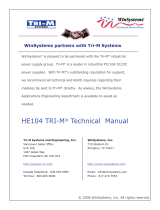
True to the Music
Radial Engineering PRO DI User Guide
4
RE-AMPING WITH YOU RADIAL PRO DI
The term re-amping comes from taking a pre-recorded guitar track and sending it back through a guitar amplifier to re-
amplify it, and then re-record it again. This trick has been used since the 1950s with artists as diverse as Les Paul, the
Beatles and Steely Dan.
It’s simple to do: plug your electric guitar into the PRO DI and send the thru-put to your guitar amplifier. Connect the bal-
anced output on the PRO DI directly to your recording system and record a clean guitar track this way. Put a mic in front of
your guitar amp as usual and record it to another track at the same time. You will now have both the amplified sound and
the direct clean sound recorded on separate tracks. Now take the clean recorded track and send it back through the PRO
DI in reverse. To do this, you will have to get a female to female XLR turn-around adaptor, as you will be connecting the
output of your mixer to the XLR OUTPUT of the PRO DI. Keep the mixers output level low to avoid saturating the PRO DI's
transformer which would cause distortion. Now, simply connect the INPUT (remember, we’re connecting this in reverse)
on your PRO DI to your guitar amplifier and/or effect pedals inputs. Using your PRO DI in reverse to re-amplify your sound
can be great fun and adds tons of creative options to a recording. This now lets you listen to various distorted sounds and
create new tones while you are sitting in front of your studio monitors.
FAQ
Why is the PRO DIs output not as loud as the output from a keyboard or active preamp?
The PRO DI is a passive direct box and is designed to output a microphone level. This allows the PRO DI to be used along-
side other microphones in a snake system and connect to the microphone input on a mixing console.
Will phantom power hurt my PRO DI or devices connected to it?
No. Phantom power will simply be ignored by the PRO DI as well as blocked from reaching any device connected to it.
Do I really need a DI? Can I not simply connect my instruments directly into the mixer?
Of course you can! Instruments can connect directly to a mixer using a hi-Z unbalanced “guitar” cable up to 20 feet long.
The advantage of using a high quality direct box is lower noise and proper impedance matching. This will result in better
sound, especially when connecting to professional audio equipment that accepts balanced signals and/or when the instru-
ment signal must travel through cables longer than 20 feet to a mixing console.
I heard active direct boxes can be better than passive. Is this true?
Both active DIs and passive DIs have their place in professional audio, just like condenser and dynamic mics do. Active DIs














